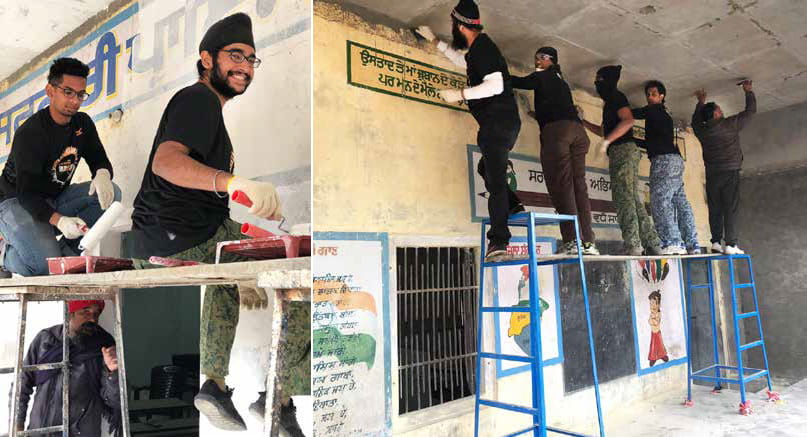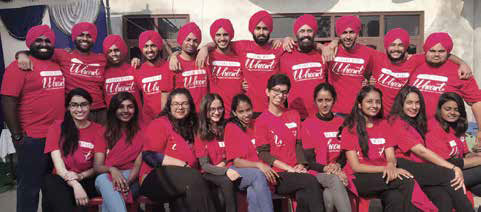Stories > Lessons in Relativity
Lessons in Relativity
Singaporean volunteers learnt a few things in the process of helping to renovate schools among marginalised communities in India’s Punjab region.
BY Tan Keng Yao
nlike most students who travel on vacations or relax at home, Sonya Gill found herself doing manual labour during the year-end school holidays. Together with about 20 other Singapore youths, she rolled up her sleeves to help refurbish a school in the village of Rattoke in Punjab, India.
There, they painted walls, installed a water filtration system and reconstructed toilets. They also stocked the school library with 3,000 donated books, and distributed necessities to villagers.
Gill and her teammates were in Rattoke under Project Khwaish, an annual community service initiative organised by Singapore’s Young Sikh Association (YSA). True to its namesake, which means “aspirations” in Punjabi, the project has been taking young Singaporeans to India’s Punjab region every December since 2003 to work on improving village schools.
Initially conceived to help Singaporean Sikh youths connect with their cultural roots while gaining skills in teamwork and leadership, the project has – over the years – drawn a mix of South Indian, Chinese and Malay volunteers.

As a reflection of Singapore’s multicultural make-up, the volunteer team comprised members of both Punjabi and other ethnic backgrounds
EMBRACING THE UNFAMILIAR
Bound by a common goal, Gill and her teammates soon came to realise that wishing to do good would entail making significant adjustments to their personal expectations. In Rattoke, the youths went without their usual creature comforts, staying with the villagers, sleeping on the floor, and having simple meals alongside their hosts.
As Singaporeans who were used to a certain level of efficiency in their home country, they also had to accept a new way of doing things.
“In the village, simple tasks like ordering tubs of paint can take up to a full day. The team, therefore, had to work faster and longer hours to complete the project within a feasible timeline,” explains three-time volunteer and YSA president Sarabjeet Singh.
But the youths took the blips in their stride, learning that a high level of efficiency was not something that came naturally to those who lacked the resources.
The resilience and resourcefulness of the Punjabi villagers also left a lasting impression on the volunteers.
Singh recalls an incident when the Singaporean team needed additional paint colours while working on murals. While their immediate reaction was to purchase more paint, the Punjabi students suggested mixing the existing colours to get new ones instead.
“It was a creative solution to a problem that we would have otherwise resolved by spending more money!” he says.
“Rendering Assistance Symbolises Singapore’s Friendship With Other Countries, And Shows That Despite Our Small Size, We Are Willing To Offer A Hand During Difficult Times.”
Sarabjeet Singh, President, Young Sikh Association Foundation
BONDING ACROSS DIFFERENCES
Then there were the language barriers. The two communities were only able to carry out rudimentary conversations with some hand signs thrown in, because not all the volunteers spoke Punjabi.
As one of only five people in her group who did, Gill had to step in as interpreter whenever the locals wished to explain something to her teammates in detail.
The biomedical undergraduate recounts a funny incident that took place.
“One of my teammates was playing ball with the students when it started to get dark. Instead of saying ‘I can’t see well’, he said in broken Punjabi ‘I have no eyes’.” she chuckled.
“Everyone burst out laughing.” Yet the volunteers’ effort to learn and speak the local language did not go unnoticed.
This, says Gill, gave her team the motivation to continue using the few Punjabi words and phrases they had picked up. On their part, the Singaporeans made it a point to engage the village students in conversation, which allowed them to gain confidence in their Englishspeaking abilities. “You could say we helped each other to understand what was going on,” she muses.
What truly moved Gill, though, was the villagers’ generosity of spirit despite their difficult living conditions.
“The locals were extremely welcoming and made us feel at home. From the head of the village to the kindergarten pupil, everyone showered us with so much love,” shares Gill.
|
The YSA’s 20-strong team travelled to rural areas of Punjab state in North India to refurbish a school, which included reconstructing toilets and installing a water filtration system |
“Villagers would come and ask to help when we were working. They also tried to accommodate our eating habits in simple ways, such as serving us milk without sugar, or cooking rice without green peas.“ Indeed, the friendships made over spending three weeks together have endured. On a recent visit to Punjab for a relative’s wedding, Gill took the opportunity to stop by the village with her mother and grandmother. |
“The villagers remembered almost everyone’s names on the team and asked about them. This made our entire volunteer trip even more fruitful and worthwhile!” she says.
Both communities were also able to glean insights into each other’s way of life. The volunteers grew so comfortable in their new environment that they started immersing themselves in village life, waking up at five every morning to pray with the locals at the gurdwara (Sikh temple).
For the villagers, witnessing the multi-ethnic Khwaish team work and live in harmony left a deep impression – as did seeing the young Singaporean men and women interact on an equal footing. “In traditional Punjabi culture, males and females are treated very differently. Those from the villages do not mingle so comfortably with the opposite sex like we do,” explains Gill.
“I hope that this will expose them to a new and more progressive way of thinking, and slowly open up more opportunities for the girls.”
On a personal level, Gill calls being a part of Project Khwaish one of the best decisions she has made. “The project was a humbling experience, as it made me realise how much I take for granted in Singapore,” she reflects.
“It taught me that happiness is in our own hands and does not wholly depend on our social situation.”
“For The Villagers, Witnessing The Multi-ethnic Khwaish Team Work And Live In Harmony Left A Deep Impression – As Did Seeing The Young Singaporean Men And Women Interact On An Equal Footing.”
WORK IN PROGRESS
Since its founding, Project Khwaish has reached a total of 19 schools in villages across Punjab. Having taken a break in 2018 to relook some areas in making the programme more relevant for both the volunteers and beneficiaries, it is planning to make a comeback this year.
Plans in the pipeline include working with Punjabi schools on a long-term basis to continue developing the school infrastructure.
On top of that, they hope to impart skills on entrepreneurship to Punjabi students so they can start small-scale businesses that not only uplift them but also cater to the needs of their community.
Singh explains that the effort will require more local partners such as university student groups who wish to take on social enterprise initiatives in rural areas.
He is hopeful that exchanges between youths from such diverse backgrounds will help to cultivate better mutual understanding.
The project also wants to move closer to home by working with South Asian migrant workers in Singapore, for instance. But at its heart is a commitment to contributing towards regional humanitarian efforts.
“Rendering assistance symbolises Singapore’s friendship with other countries, and shows that despite our small size, we are willing to offer a hand during difficult times,” concludes Singh.

